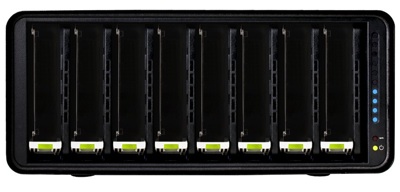Over the years, I’ve had many different backup solutions in place in my home to back up the now >3TB of data I deem worthy of the trouble. I’ve used RAID levels 0, 1, 5 and 6. I’ve used complete solutions and DIY on all the major platforms, as well as Linux flavors like Debian, Yellow Dog and Slackware. I’ve automated these processes, backing up crucial data online, offline, near-line and off-site, and de-automated them whenever I’ve slacked off on my documentation and have forgotten what’s backing up to where and when. Through this experience, I have a decent idea of what works well and what doesn’t.
To bolster available storage to these various configurations over time, I’ve added both internal and external drives, using LaCie almost exclusively for the external side of things. I’ve purchased dozens of these drives over many years and, up until the last couple, have had good experiences with them.
Case in point: yesterday morning, I woke up to find that backups had failed overnight, making this the third set of their products (I always buy them in pairs) that have failed me in the last 2 years. Over the last two years, I’ve lost 6 total, in each case just days after the manufacturer warranties expired. I purchased these drives based on logic that by spending $300-$400 on each, I was getting an acceptable level of reliability for less than it would cost for an enterprise-class solution costing significantly more. Note, it’s not the hard drives that fail, rather the enclosures LaCie builds around them. I end up using the drives in other ways, as noted below.
Thus, I found myself slowly starting to wake up from more than a good night’s rest. I started to realize that I have all of my critical project data in only one location. I had to decide how to proceed in order to keep it safe. Unsatisfied with my past methodology, I set out for some solution evolution.
After spending the morning reading reviews, again comparing complete vs. DIY solutions, I purchased a DroboPro:
Here’s the front:

Internal pic:

Back:

Yes, you can see a USB 2 port, 2 Firewire 800 ports and indeed that’s a Gigabit Ethernet port for iSCSI : )
The DroboPro was $1,289.95
The new drives: 4 x $119.99 = $479.96
Total cost: $1,769.91
That may seem steep, and it is, however, compare this to the cost of 6 failed drives over two years @ $300 each. And my time and worry.
The logic is that spending $1800 on consumer-grade hardware, while thinking it a less-expensive route, is actually more costly as time spent installing, configuring, maintaining and replacing these *solutions* is far more pricey than spending more upfront on a solution that will stand the test of time and allow for more flexibility, security and reliability.
You can count on me sharing my thoughts here on the DroboPro after it’s been in place in my studio for a few months.
* thanks to Chris Connaker @ Computer Audiophile for the images
=
c